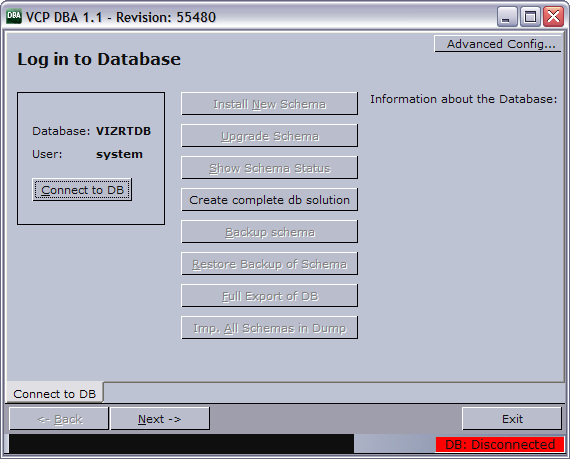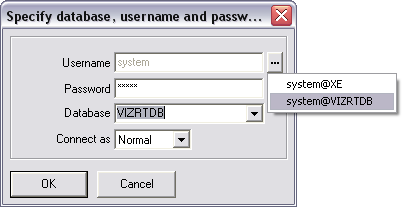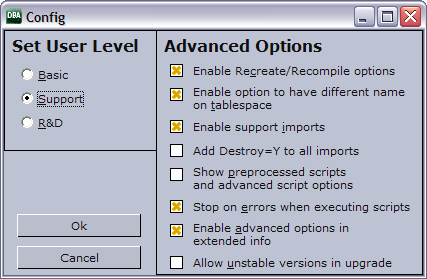
Viz Pilot User Guide
Version 7.2 | Published May 08, 2017 ©
User Interface
Starting the client will open the Connect to DB window which is the initial screen of Pilot DBA. This screen gives the user several options; the Database Login, different Management Options and Advanced Configuration of user levels.
This section contains the following topics:
-
Connect to DB
-
Database Login
-
Advanced Configuration
-
Schema Status
-
Connection Status
-
Database Error Logs
Connect to DB

The Connect to DB tab is the initial startup window where the user can perform the Database Login, set user levels and initiate different Management Options.
-
Connect to DB/Change DB: Enables the user to log on to the database.
-
Advanced Config ...: Enables the user to select a default user level or create a custom user level.
-
Install New Schema: Enables the user to install a schema on the specified database. See Install Schema.
-
Upgrade Current Schema: Enables the user to upgrade the current version of the schema to a later version. See Upgrade Schema.
Note: The application first scans the installed schema for critical errors and blocks the option to upgrade if any critical errors are found.
-
Show Schema Status: Enables the user to see the status of the currently installed schema. See Show Schema Status.
-
Create complete db solution: Enables the user to create a complete database solution. See Create Complete DB Solution.
-
Backup Schema: Enables a user to export a database dump of the schema. See Backup Schema.
-
Restore Backup of Schema: Enables the user to import a database dump of a schema. See Restore Backup of Schema.
-
Full Export of DB: Enables the user to perform an export of the entire database. See Full Export of Database.
-
Imp. All Schemas in Dump: Enables the user to import all schemas in dump. See Import All Schemas in Dump.
Database Login

In order to successfully connect to a database, a local net service name must be configured for the Oracle database client using Oracle’s Net Configuration Assistant.
-
Username: Displays the pre-configured system user.
-
Password: Sets the password for the system user.
-
Database: Sets the database service name or connection string.
-
Connect as: Sets the connection privileges. Available options are Normal, SYSDBA or SYSOPER.
See Also
Advanced Configuration

-
Set User Level: Shows the available user modes.
-
Basic: This user level is for users who are doing regular maintenance and fresh installations or upgrades of the database schema.
-
Support: This user level is mainly used by Vizrt’s support personnel and skilled administrators who are doing special customizations to an existing installation or fixing common errors found in schemas.
-
R&D: This user level is for use by Vizrt’s R&D department when doing development or searching for bugs that is not solved by customer support.
-
-
Advanced Options: Shows the available options.
-
Enable Recreate/Recompile options: This enables the Recreate/Recompile options in the Schema Status window and the button to recreate AQ tables in Extended Info-AQ & Purge Job.
-
Enable option to have different name on tablespace: Enables the user to select a different tablespace name. Default is the same as Schema name.
-
Enable support imports: Enables "support only"-version in the combo box for selecting version for import. This is to import a single schema without first installing a new schema, so that Vizrt can debug the schema. Also enables "Imp.All Schemas in Dump" option.
-
Add Destroy=Y to all imports: Overwrites tablespaces if already found.
-
Show preprocessed scripts and advanced script options: Shows an extra tab before executing the chosen script where the user can see through the pre-processed script or reload it.
-
Stop on errors when executing scripts: Stops the execution of scripts when errors occur. For versions 5.1.7 and later this option should be enabled. For older versions than 5.1.7 this option should be disabled.
-
Enable advanced options in extended info: Enables the buttons to activate/deactivate the AQ triggers and purge job, and the button to delete all entries in the errlog table older than 3 months.
-
Allow unstable versions in upgrade: Allows the schema to be upgraded to/installed as an unstable version, meant for use by Vizrt staff only.
-
Schema Status

-
Save icon: Creates a packaged file (zip) with debug information. The file can be sent to support for external help with the database.

Note: If dump files are not created as expected, check that Pilot DBA’s installation path does not contain spaces.
-
Upgrade Application Schema: Enables the user to upgrade to a new schema.
-
Run Custom Script (Advanced): Enables the user to run a custom script, specific to the database.
-
View Extended Info (Advanced): Enables the user to display extended information about the schema.
-
Recreate all constraints (Advanced): Enables the user to execute a script that recreates all constraints in the schema. Typically needed after a "support only" import, or if some constraints for some reason are missing. Missing constraints are reported in the status window.
-
Recreate all sequences and recompile schema (Advanced): Enables the user to recreate all sequences in the schema and then recompiles the entire schema. This is usually done by normal imports, but could be needed if something went wrong during the import, or if “support only" import was used. This will also fix problems that might appear if for some reason a manual import was done.
-
Recompile schema (Advanced): Enables the user to recompile all packages, triggers, functions and procedures.
Connection Status

The connection indicator field at the bottom right shows the connection status for Pilot DBA to the database. It is red when disconnected, and green when connected. If the connection is lost try clicking on this field to reconnect to the database.
See Also
Database Error Logs

When errors occur during operation, an indicator is shown in the lower right of Pilot DBA’s user interface. Clicking this warning indicator will open a log window with the following three logs:
-
VCPDBA.log: Shows the main application log.
-
VCPDBA_SQL.log: Shows the SQL output from the last script that was executed.
-
vcp_ora.log: Shows the log for the internal Oracle module.
All log files are stored in the same directory as the Pilot DBA application.
Note: All vcp_ora.log files are added to the _vcp_ora.log.old _file.
Database log files
The alert logs for the Oracle Viz Pilot database are generally found in the following locations, although this may differ slightly on your system:
-
C:\oracle\diag\rdbms\<dbname>\<SID>\alert\log.xml
-
C:\oracle\diag\rdbms\<dbname>\<SID>\trace\alert_<dbname>.txt